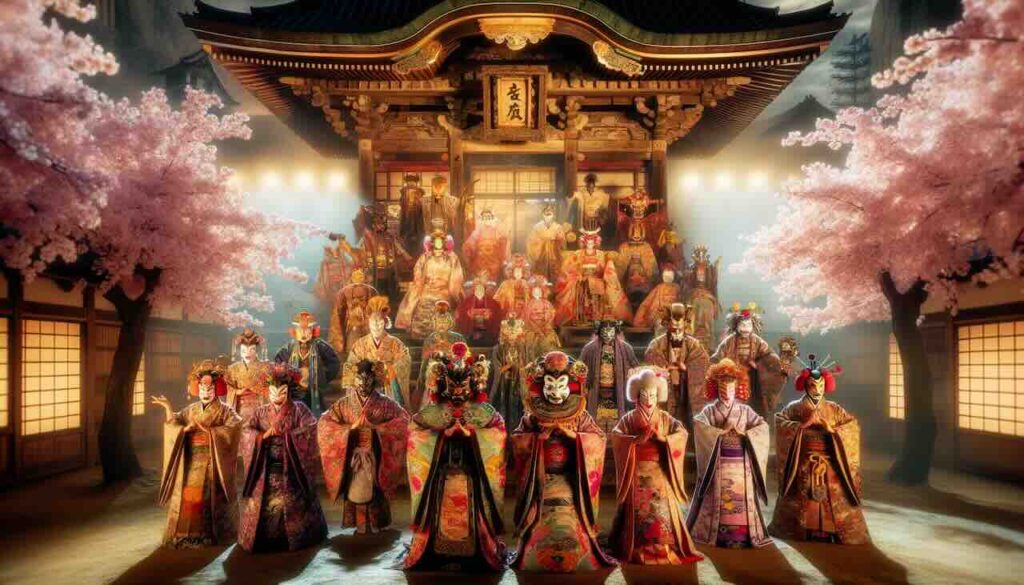When exploring the world of Japanese traditional performing arts, names like Noh, Kabuki, and Kyogen often dominate the conversation. Yet hidden further back in Japan’s cultural lineage lies Gigaku (伎楽) — an ancient masked dance-drama that predates all of them and offers remarkable insight into Japan’s early cultural exchanges, religious ceremonies, and theatrical evolution.
- What Is Gigaku?
- The Origins of Gigaku: A Cross-Cultural Birth
- Gigaku’s Peak During the Nara Period (710–794)
- The Decline of Gigaku and Its Evolution (Heian Period Onward)
- Revival Efforts in the Modern Era
- Gigaku’s Broader Significance in Japanese Performing Arts History
- Summary: The Enduring Legacy of Gigaku
What Is Gigaku?
Gigaku is one of Japan’s earliest forms of performing arts, blending elements of:
- Dance
- Pantomime
- Music
- Exaggerated full-head masks
Unlike Noh or Kabuki, Gigaku performances relied almost entirely on wordless physical storytelling using elaborate, highly stylized masks that fully enveloped the actor’s head. This created a visually striking, almost otherworldly performance style, combining ritual, entertainment, and court ceremony.
The Origins of Gigaku: A Cross-Cultural Birth
Arrival in Japan
Gigaku was introduced to Japan in 612 CE by a performer named Mimaji, who had studied in the Chinese court before arriving from the Korean kingdom of Baekje (百済). He brought with him a sophisticated art form that had flourished in Southern China’s Liang Dynasty, and which blended elements of Central Asian, Indian, and Chinese Buddhist ritual performance.
- Gigaku’s arrival coincided with Japan’s broader embrace of continental culture and Buddhism, which profoundly shaped the Nara period.
- The art was initially performed at Buddhist ceremonies and imperial court functions, where it quickly gained popularity.
Early Purpose and Tone
Gigaku’s early performances combined:
- Religious ritual elements aligned with Buddhist ceremonies.
- Secular entertainment, often featuring comedic, satirical, and sometimes risqué humor that delighted court audiences.
This duality — part sacred, part playful — reflected Japan’s characteristic ability to integrate spiritual reverence with accessible, human-centered art.
Gigaku’s Peak During the Nara Period (710–794)
During the Nara period, Gigaku was regularly performed at major state temples such as Tōdai-ji and Kōfuku-ji. Its central role in ceremonial life paralleled the increasing prominence of Buddhism within imperial politics.
The Gigaku Masks
One of Gigaku’s most defining features was its massive wooden masks, which continue to survive in temple collections today:
- Made primarily from camphor wood, often lacquered and painted.
- Characters included:
- Rikishi (力士): strongman figures
- Kongo (金剛力士): fierce Buddhist guardians
- Suiko (酔胡): drunken foreigner characters with exaggerated noses
- Konron (崑崙): depictions of foreigners, sometimes reflecting India or Southeast Asia
- Rojo (老婆): old woman characters
- Many masks reveal cross-cultural artistic influences from China, Central Asia, and India.
The masks allowed performers to present bold, exaggerated movements that communicated emotion and narrative without speech — making Gigaku accessible even to multilingual or illiterate audiences.
The Decline of Gigaku and Its Evolution (Heian Period Onward)
Heian Period Decline (794–1185)
By the Heian period, Gigaku began to lose favor:
- New forms of entertainment, including Sangaku (which eventually evolved into Kyogen) and Bugaku (courtly music and dance), gained prominence.
- Gigaku’s more secular, sometimes bawdy nature may have made it less suitable for the highly refined aesthetic preferences of the Heian court.
Extinction by Kamakura Period (1185–1333)
By the early medieval Kamakura period, Gigaku had largely vanished from public performance. However, it left a profound legacy, influencing:
- Bugaku (舞楽) — more ritualized court dances.
- Noh theatre — in its masks, physicality, and religious roots.
- Kyogen comedy — inheriting some of Gigaku’s humor.
Revival Efforts in the Modern Era
Although Gigaku disappeared as a living performance art, it was not entirely forgotten:
- Gigaku masks remain preserved in ancient temples such as Tōdai-ji, Hōryū-ji, and Yakushi-ji.
- In the late 20th and 21st centuries, academic interest and cultural preservation movements have led to reconstructed performances based on historical records.
- Occasionally, ceremonial reenactments of Gigaku are staged at Buddhist temples, allowing modern audiences a rare glimpse into this ancient theatrical form.
Gigaku’s Broader Significance in Japanese Performing Arts History
Gigaku holds a special place as:
- Japan’s oldest known masked theater tradition.
- An early example of multicultural fusion, incorporating Buddhist ritual, Central Asian music, and indigenous Japanese performance.
- A precursor to later Japanese performing arts, laying foundational elements for:
- Noh’s mask traditions
- Kabuki’s gestural storytelling
- Kyogen’s comedic rhythm
- The lion dances and processions seen at many Shinto festivals today
Summary: The Enduring Legacy of Gigaku
Though no longer a living tradition, Gigaku remains a cultural ancestor to Japan’s rich performing arts heritage. Its extravagant masks, cross-cultural origins, and Buddhist ceremonial functions reflect Japan’s early openness to outside influence while forging its own distinctive expression.
To study Gigaku is to peer into a time when Japan’s performing arts were not yet fully Japanese — but already laying the groundwork for centuries of uniquely Japanese cultural identity.


